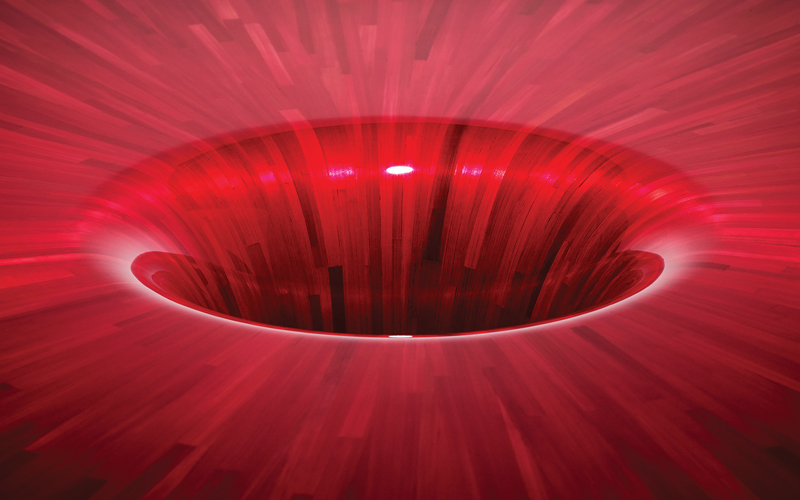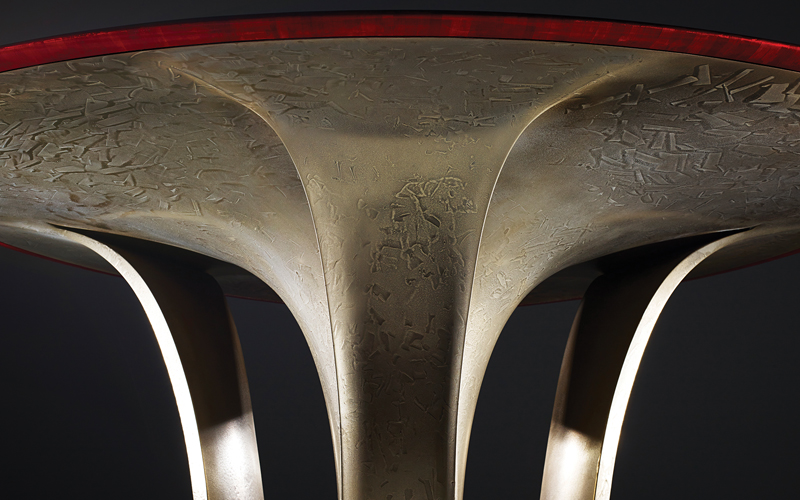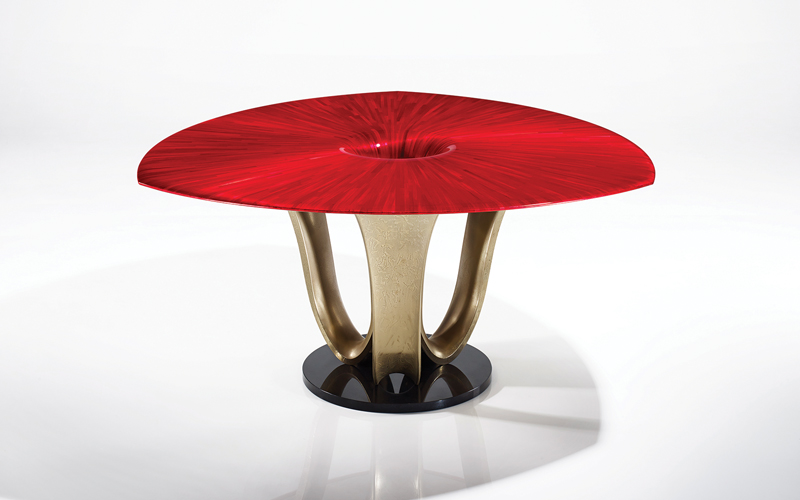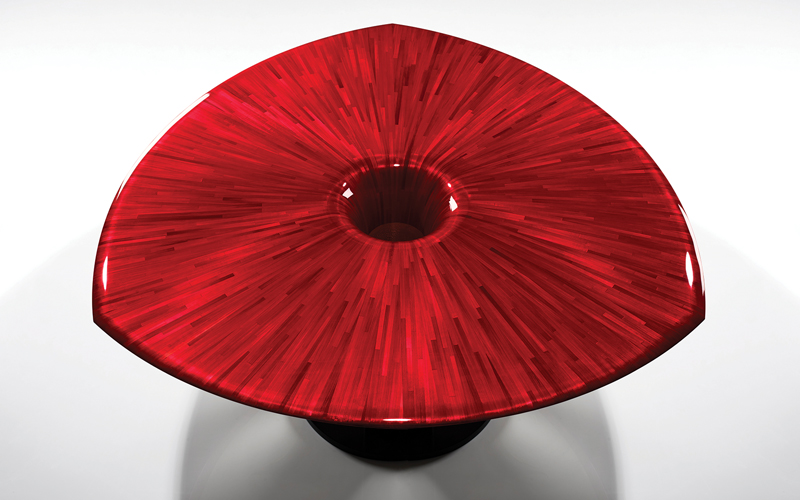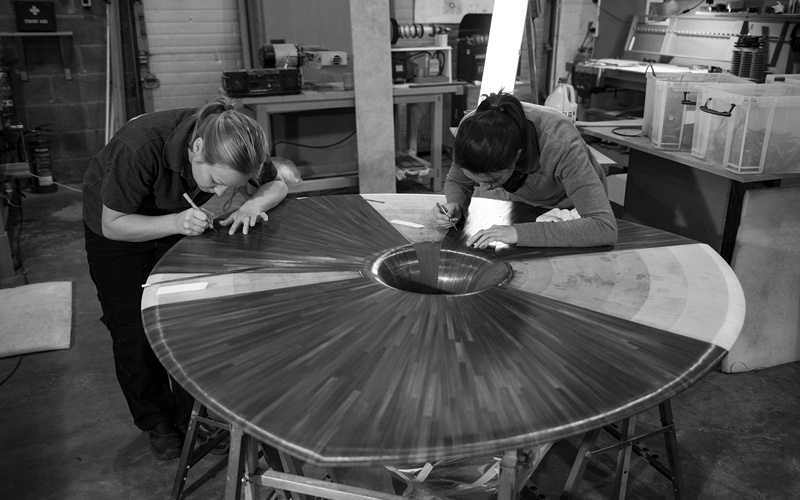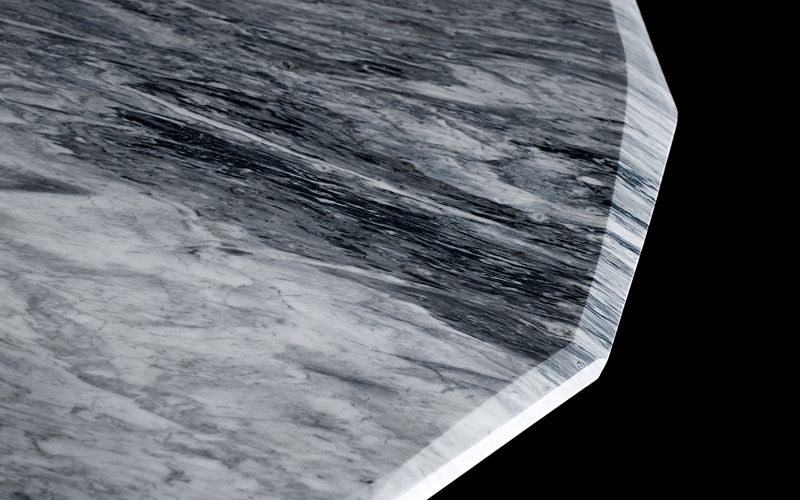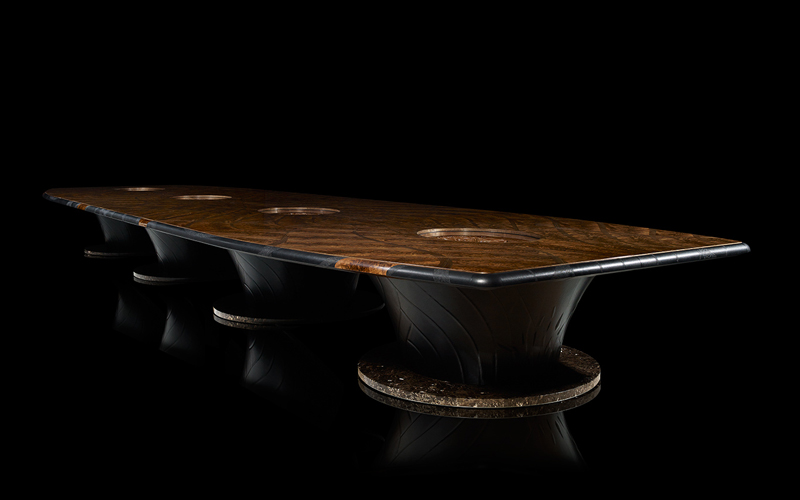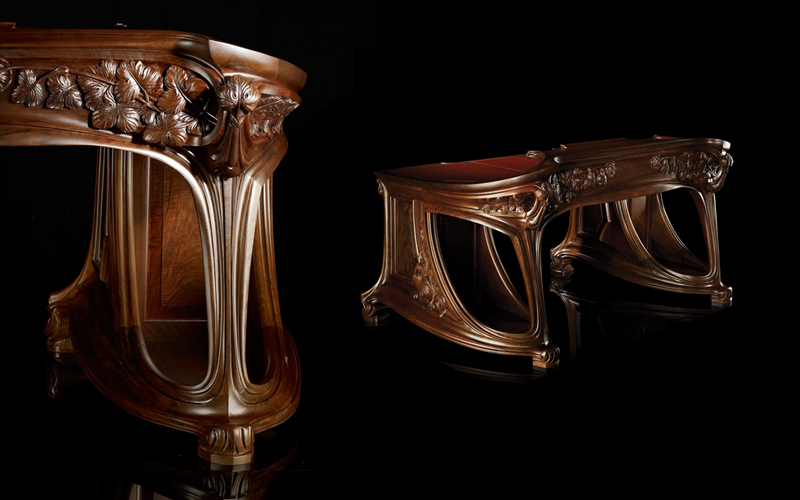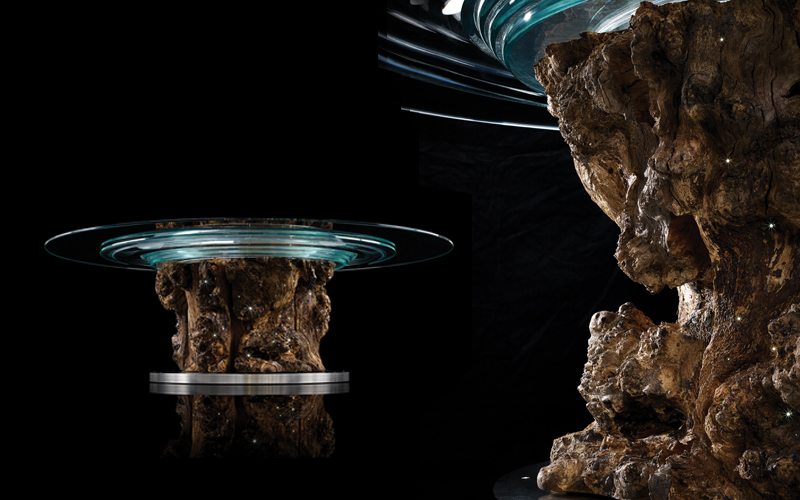You’ve probably never heard of Silverlining Furniture. And that’s absolutely fine with them. One of the most exclusive companies in the world, the UK-based firm creates truly bespoke, one-of-a-kind pieces for iconic yachts, private jets and spectacular residences around the globe. Their client list is extremely small yet includes some of the most impressive names in the financial and business worlds, many of them billionaires, as well as high-profile projects for the likes of David Bowie, Madonna and Tom Ford.
In 1985 the company was established by a 21-year-old craftsman named Mark Boddington, of the famed Boddington brewing family, who envisioned one day becoming one of Britain’s foremost furniture makers. Boddington set up shop in an old cow barn, and his now signature use of inlaid silver led him to call his new venture Silverlining. He won some important early commissions including creating a suite of furniture for the Grosvenors, one of Britain’s most prominent families, at their beautiful estate Eaton Hall.
By the 1990s celebrity clients had come knocking and Boddington found himself building pieces for David Bowie’s homes in London and New York, as well as Kevin Costner’s Hollywood mansion. Soon after he received his first commission to work on a superyacht: the Claire, owned by Prince Jefri of Brunei, and a profitable new avenue opened. 30 years after he began Boddington’s award-winning designs can also be found in palaces, museums, galleries and corporate headquarters around the world.
Today, the Silverlining Group comprises three brands: Bespoke, Collector and Editions. The goal is to become nothing less than “the most inspiring furniture brand of the 21st century” where design, craftsmanship, innovation and engineering come together to make clients’ dreams come true. Here Boddington discusses his design ethos and why true exclusivity is so hard to come by:
How did you decide to start making furniture? Was your family upset that you didn’t go into the brewing business?
I followed my passion for making furniture from the age of five, winning all the prizes at school and then gaining places at seven different colleges before deciding to train with master designer/maker John Makepeace OBE. My family were not disappointed as the brewing business was sold when I was a teenager and at least my mother was happy that I followed my passion.
What is the process for commissioning a bespoke piece from Silverlining?
We first meet and listen to clients to see if there is a fit, we show them what we can do and how we work using example commissions in portfolios with large jewelry-like samples. We get to know what interests them and what they require. We then agree an outline budget and then for an agreed design fee we develop several concept ideas with material samples to show what is possible, to stimulate conversation and input from the client.
Commissioning furniture from Silverlining is a collaboration between client, designer and maker. Once an idea is chosen the design is developed to meet all the functional and emotional requirements of the brief including any technology, audiovisual integration and ergonomics. Once the design, materials and final quotation are agreed we move into engineering drawing and in the case of some designs (such as chairs) making prototypes.
Once the engineering drawings and/or prototypes are approved we then start procuring the special materials such as a unique wood or stone. We then invite clients to see their commission in the making to appreciate the skills of our designers, craftspeople and finishers. All client love to visit our workshops, it’s all part of the journey. We deliver worldwide ourselves using a ‘white glove’ service that takes care of everything from wrapping, packing, delivery, unpacking, installation and training of crew or household staff in care and maintenance.
The term “bespoke” is widely used and abused these days. What sets apart true bespoke in your opinion?
Our vision is to be the most inspirational furniture maker of the 21st century. Firstly, by pushing the boundaries of what 21st century craftsmanship is by combining advanced materials and technology with traditional hand skills to create awe-inspiring techniques not seen before. Secondly by offering creativity without limits inspired by architecture, engineering, the arts, science and nature. Finally co-creating with the client to create an object that reflects their persona and lifestyle. For example, it’s not just a desk, it’s the client’s desk – and we only ever make one of anything.
How does bespoke furniture mirror a client’s personality?
There is always a reason that drives and interests a client, it maybe their art collection and love of color, it may be Formula One and integrating cutting edge technology, it may be lifestyle such as their informal beach house or it may be the way they work.
What are your favorite brands of watches and cars?
I love understated designs that stand the test of time. If it were a watch it would be an Art Deco Rolex Prince for its unusual rectangular shape and understated design - the total opposite of a modern Rolex. I drive a 12-year-old Maserati GranTurismo, again with beautiful understated lines and a wonderful design ethos, in charcoal grey but with oxblood red leather seats for an edge. I also have a 1985 Porsche 911 SuperSport Targa that I am totally restoring – a rare beast of a car.
What do you like about working on private yacht and jet projects?
Each and every project is a challenge; we are so privileged to collaborate with the world’s best architects and yacht designers and our clients. Yachts and jet interior spaces present special challenges as well as the changing environment and vibration. Yacht and jet owners are pioneers and they really want to leave a legacy in design and fine craftsmanship by being the catalyst for groundbreaking projects.
Is it true that you’ve only had about 30 clients in the last 30 years? Why did you decide to maintain such a small client list?
Yes, we have a very small list of clients; it’s actually nearly 40 now! There are several reasons. Firstly, we now work for the children and grandchildren of our first clients. Secondly, they often have many homes and yachts, so we are always working on a project for many clients. Thirdly, the scale, detail and therefore value of our work has grown over the years. Lastly, most clients stay with us for life, so we only need one new client a year to grow the business.
How would you describe your ideal client?
Leaders in their field who appreciate the micro detail of our work and the thought and skill that goes into each piece. They are supporters of the arts, philanthropic and interested in leaving a legacy, make a difference. They are detail people. They understand about detail and integrity. For example, they appreciate the level of finish on the inside and back of the furniture, not just the seen surfaces, the way the drawers open, the selection of special materials, the matching of veneers or the quality of hardware etc. They care about supporting the next generation designers and craftsmen.
How does someone go about becoming a new client?
Normally it’s through our network, and existing clients or they buy a house or yacht we have worked on or an art gallery or consultant brings Silverlining to their attention. Either myself or Jason Chadda (Director at Silverlining) would meet them to discuss the possibilities and how the process might work. Unfortunately, just paying money does not get you in the family. The relationship needs to be right where by working together we can create a magical object/project. Clients have to be patient as we have a long waiting list and refuse to compromise on quality of design or craftsmanship.
Is it easier or more difficult doing business with billionaires? Are you ever instructed that money is literally no object?
Billionaires are very inspiring people and always at the top of their game and often changing people’s lives. However wealthy, everybody always has a budget, but it’s not about money, it’s about creating an extraordinary object and leaving a legacy. I suppose the phrase is “perceived value”.
What was it like working with the likes of David Bowie, Madonna and Tom Ford?
They all know about style and what it takes to create a really great piece of work. David Bowie was an inspirational client wanting to know every detail and personally thanking every craftsman that worked on his projects – a real gentleman. Tom Ford as you would expect is a doyenne of style and his furniture reflected his persona.
What is your definition of 21st century craftsmanship?
Combining the very best human minds and hands with today’s advanced materials and technology to push the boundaries of craftsmanship.
What are some of the most remarkable projects you have completed for your clients?
The simple answer is the next project. Over the years I never expected to be involved in such incredible projects. Two examples would be the award winning 96-meter (315-ft.) motor yacht Palladium, and the other an entire house we worked on for three whole years in Moscow.
What’s the most difficult commission you’ve ever had?
Creating a copy of an antique Art Nouveau desk. We were not allowed to photograph it, so we had to sketch the desk from memory. The flowing shapes were too complex to draw in 3D, so we decided to make an actual half sized desk. The desk was made entirely made out of solid English walnut which took two years to find, and the desk itself took 6,200 workshop hours to prototype, make and finish.
Are there any commissions you’ve had to turn down, and why?
Yes, often we have potential clients who just want to throw money at a project but not be part of the co-creation process. Our work is only as good as the patron that commissioned the furniture and the interaction they have on the journey.
What are some of the most rare and exotic materials you’ve sourced for client’s projects?
428-year-old brown oak burr planted to mark the birth of an English aristocrat at Castle Howard. Reindeer leather sourced from a ship called the Metta Catharina that sank in 1786 off Cornwall England, sat at the bottom of the sea for over 200 years, was salvaged, restored and still used now (not much left though!). Walnut curl veneers as you find on rare gunstocks – admired for their beauty and grain.
Is there anything you haven’t done yet that you would like to design some day?
Yes, I would like us to design a collection of more accessible furniture that combines the very best of the designer and the maker. Good design does not always have to be expensive if made in numbers which gives opportunity to perfect production through repetition – a luxury we don’t have as we only ever make one of anything.

